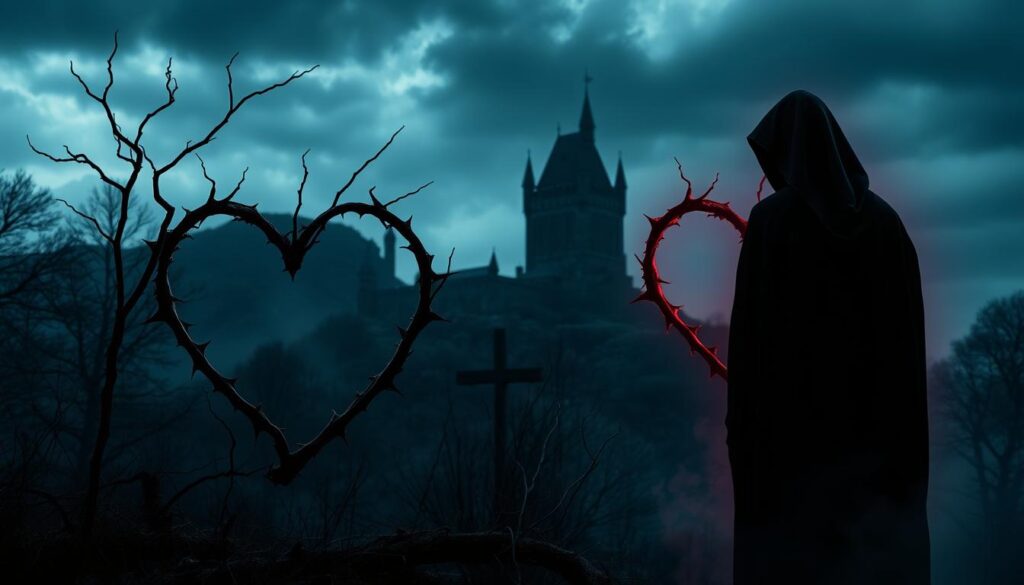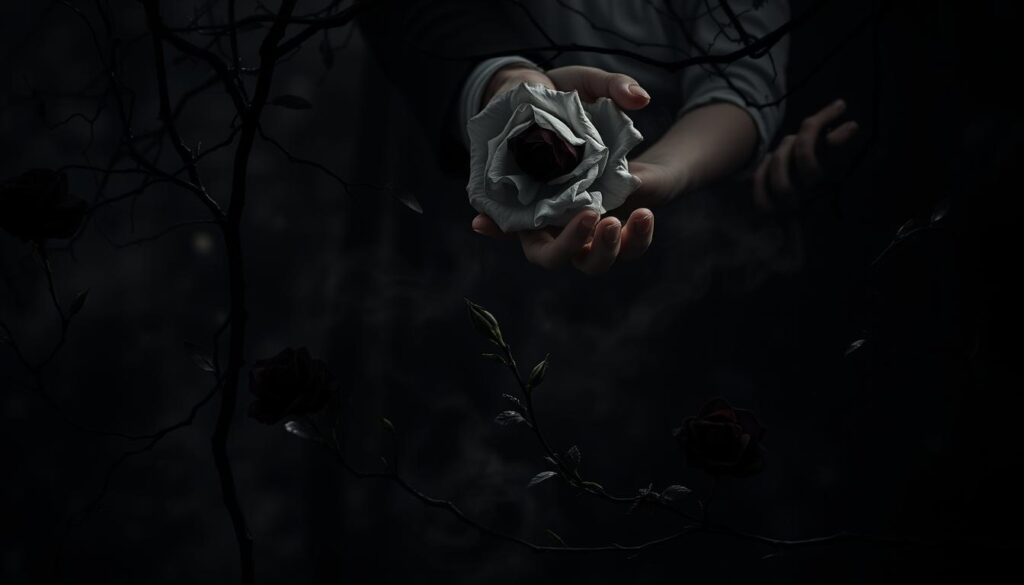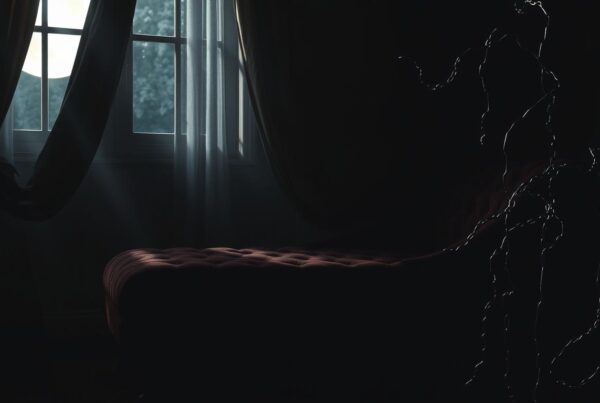Dark romance has been a hit for centuries. It pulls readers into a world where love and control mix. These stories show the dark side of love, revealing the mind games in toxic relationships.
We’ll look closely at how dark romance uses mind games. We’ll see how authors create these intense stories. And why people love reading about twisted love.
By looking into these stories, we learn more about dark romance. It changes how we see love and relationships. Let’s dive into the world of manipulation in books and its impact on us.
The Allure of Dark Romance in Literature
Dark romance draws readers in with its mix of love and danger. It combines passion with risk, making stories that excite and disturb. Gothic romance, a big part of it, often has brooding heroes and mysterious places.
Defining Dark Romance
Dark romance goes beyond usual love stories. It dives into deep feelings and tricky situations that question what we think of love. These stories mix psychological thrillers with romantic suspense, keeping readers hooked.
Historical Context of Dark Romantic Narratives
The start of dark romance is in Gothic literature of the 18th century. Classics like “Wuthering Heights” laid the groundwork for today’s dark romances. The genre has grown, adding psychological depth and suspense that readers love today.
Psychological Appeal to Readers
Reader psychology is key in why dark romance is so appealing. These stories let readers explore forbidden topics and complex feelings in a safe way. The mix of love and danger offers a unique thrill, satisfying our curiosity about the darker sides of love and relationships.
Common Themes in Manipulative Romantic Storylines
Dark romance novels often explore twisted relationships that captivate readers. These stories frequently revolve around manipulative behaviors that create intense drama. Control plays a central role, with characters vying for dominance in their relationships.
Jealousy fuels conflicts and drives characters to extreme actions, keeping readers on edge.
Gaslighting emerges as a powerful tool in these narratives. Characters manipulate their partners’ perceptions, making them question their own reality. This psychological tactic adds layers of complexity to the storyline, blurring the lines between truth and deception.
Emotional abuse takes center stage in many dark romances. Characters use hurtful words and actions to maintain power over their partners. This creates a toxic dynamic that paradoxically draws readers deeper into the story.
The power imbalance between characters becomes a driving force, shaping their interactions and decisions.
Codependency often develops as characters become entangled in unhealthy relationships. They struggle to break free from destructive patterns, even as they recognize the harm. This internal conflict adds depth to characters and keeps readers invested in their journey.
These themes combine to create compelling, albeit unsettling, narratives that explore the darker side of love.
Twisted Hearts: Analyzing Manipulation in Dark Romantic Narratives
Dark romantic stories grab our attention with their deep relationship stories. These tales often show characters who control their partners through emotional tricks. Looking closely at these characters helps us see the deep reasons behind their actions.
Identifying Manipulative Behaviors
In dark romance, characters use sneaky ways to shape their partners. They might use gaslighting, guilt trips, or love bombing. Spotting these tricks helps us see the power battles in the story.
Power Dynamics in Relationships
The power balance is key in dark romance. One person usually has more control, leading to tension and conflict. This power imbalance moves the story along and shapes how characters interact.
Emotional Exploitation as a Plot Device
Authors use emotional tricks to make their stories exciting. Characters might use their partners’ weak spots, fears, or wants to get what they want. This makes the story richer and keeps readers hooked on the changing relationship.
Getting these points helps us enjoy dark romance books more. It lets us see how complex the characters and their relationships are in these compelling stories.
Character Archetypes in Dark Romance
Dark romance novels have complex characters that mix good and evil. The antihero is often the main character. They are flawed and have inner struggles.

The femme fatale is a key figure in these stories. She’s seductive and dangerous, with hidden motives. Her charm draws the main character into passionate but risky relationships.
The villainous love interest is the opposite of the main character. They seem charming but hide dark secrets. This creates a thrilling dynamic between the characters.
These archetypes create a world where love and danger mix. Readers are pulled into a story of passion, betrayal, and moral gray areas. The complex relationships between characters drive the story, showing the darker side of love and human nature.
The Fine Line Between Love and Obsession
Dark romance novels often mix passionate love with unhealthy obsession. These stories dive deep into human emotions, sometimes crossing dangerous lines. Readers get pulled into worlds where love is all-encompassing, making them question what’s healthy in relationships.
Unhealthy Attachment Styles
Attachment theory is key in understanding obsessive love in fiction. Characters often show anxious or avoidant attachment, leading to intense, sometimes toxic interactions. These stories can change how readers see love in real life.
Romanticizing Toxic Behaviors
Dark romance often makes harmful behaviors seem romantic. Possessiveness, jealousy, and control are seen as signs of deep love, not warning signs. This can confuse readers about what’s healthy in relationships.
Reader Influence and Perception
The effect of these stories on readers is huge. While many see the fantasy in dark romance, others might take on harmful ideas. It’s important for readers to think critically, knowing the difference between fiction and real-life relationships.
Psychological Manipulation Tactics in Fiction
Dark romance stories often show characters using mind games. These tricks are like what happens in real-life abuse. Gaslighting, for example, makes victims doubt their own thoughts and feelings.
Love bombing is another trick seen in these tales. It’s when someone shows too much love and then pulls back. This makes the victim feel like they’re on an emotional rollercoaster.
Isolation is a key way to control someone. Manipulators try to cut their victims off from friends and family. This makes the victim feel alone and trapped.
Emotional blackmail is a powerful tool in these stories. It’s when someone threatens to harm themselves if they don’t get what they want. This makes the victim feel scared and guilty for saying no.
The Evolution of Dark Romance in Modern Literature
Dark romance has changed a lot in the digital age. Social media helps readers connect with stories in new ways. This changes how characters and plots are shaped.
Social Media’s Impact
Digital platforms spread dark romance stories fast. Fans share quotes, talk about plots, and reach out to authors. This feedback loop makes stories and characters evolve together.
Consent in Literature
Views on consent in books are changing. Modern dark romance shows complex power struggles and the need for agency. Writers carefully mix intense love with respect for boundaries.
Trope Subversion
Authors are shaking up old romantic storylines. They turn power dynamics on their head, create new character types, and explore unusual relationships. This makes the genre exciting and sparks talks about love and power.
Analyzing Consent and Agency in Dark Romantic Narratives
Dark romantic stories often blur the lines of consent and character agency. Writers face tough choices when crafting these complex tales. They must balance gripping drama with responsible storytelling.
Consent in fiction is a tricky subject. Characters may make questionable choices that readers find disturbing. Yet these decisions can reveal deeper truths about human nature. Authors walk a fine line between authentic portrayals and glorifying harmful behavior.

Character agency plays a key role in dark romances. Protagonists grapple with intense feelings and difficult circumstances. Their choices drive the plot forward, even when those choices seem unwise. Skilled writers give characters autonomy while exploring the consequences of their actions.
Power imbalance is a common theme in these stories. One character may hold sway over another through wealth, status, or manipulation. This dynamic creates tension but raises ethical concerns. Authors must handle such relationships with care to avoid romanticizing abuse.
Ethical storytelling demands thoughtful consideration of these issues. Writers can use dark themes to explore human complexity without endorsing harmful behavior. By showing both the allure and danger of toxic relationships, they encourage readers to think critically about love and power.
The Impact of Dark Romance on Reader Expectations
Dark romance stories change how we see love and relationships. They can alter our views on romance in real life. These stories have the power to shape our thoughts and feelings about love.
Shaping Relationship Ideals
Dark romance books show intense, passionate bonds. Readers might want similar experiences in their lives. This can lead to unrealistic expectations in relationships.
Risks of Normalizing Toxic Behaviors
Some dark romance stories show unhealthy actions as romantic. This can make harmful behaviors seem okay. It’s important to remember that fiction isn’t always healthy.
Fostering Critical Reading Skills
To fight these risks, we need strong media literacy. This means thinking deeply about what we read. We should question character actions and motivations.
By doing this, we can enjoy dark romance while keeping a healthy view of love. Critical thinking helps us know the difference between fiction and reality in love.
Literary Techniques Used to Portray Manipulation
Dark romantic stories use clever tricks to show manipulation. Writers carefully craft these tales. They use techniques that lead readers through twists and turns.
The unreliable narrator is a key tool in these stories. This narrator might hide or twist the truth. It makes readers wonder what’s real. This adds mystery and keeps us guessing about characters’ true motives.
Foreshadowing is also important. Writers give subtle hints about future events or traits. These hints build tension and prepare us for manipulative acts. On a second read, we can see how these hints fit into the story.
Dramatic irony is another key technique. It happens when we know something the characters don’t. This creates a sense of dread or anticipation. It shows manipulation happening, even before the characters know.
Symbolism adds depth to these stories. Objects, colors, or actions can have deeper meanings. They might show a character’s true nature or the manipulation. Symbols are often subtle, making us think more about what’s happening.
These techniques work together to create a complex story. They draw us into the tale, making us feel the impact of manipulation. By using these tools, writers make dark romances that stay with us.
Cultural Influences on Dark Romantic Narratives
Dark romantic tales show what societies value around the world. They reveal how love and power mix in different cultures. Through global literature, we see many views on love and social norms.
Cross-Cultural Perspectives on Love and Power
Dark romance novels from different countries offer unique views on love. In some places, being passionate is romantic. In others, it’s seen as controlling. These views change how we see manipulative behaviors in stories.
Societal Norms Reflected in Dark Romance
Books reflect the rules of their society. Dark romances often challenge these norms. They might show women in powerful roles or men being vulnerable. This shows how real-life relationships are changing.
Gender Expectations in Manipulative Relationships
Gender roles are key in dark romantic plots. Stories might show men as dominant and women as submissive. Or they might flip these roles to challenge our views. Characters’ actions often come from societal views on gender.
Understanding these cultural factors helps us see dark romance stories in a new light. It shows how books can both reflect and shape our views on love and power.
Ethical Considerations for Authors and Readers
Dark romantic stories are a delicate mix of art and influence. Authors must write responsibly, balancing creativity with the impact on readers. They should include content warnings to help readers choose what they read.
Readers have a big role in how they consume dark romance. It’s key to see the difference between fiction and real life. They should not idealize harmful behaviors shown in stories.
Trigger warnings are crucial in dark romance books. They help readers prepare for sensitive content. Authors who use these warnings show they care about their readers’ feelings.
Writers and readers both must think carefully about dark romantic stories. By writing responsibly and consuming ethically, we can enjoy these complex tales. This way, we keep a healthy view of real-life relationships.



